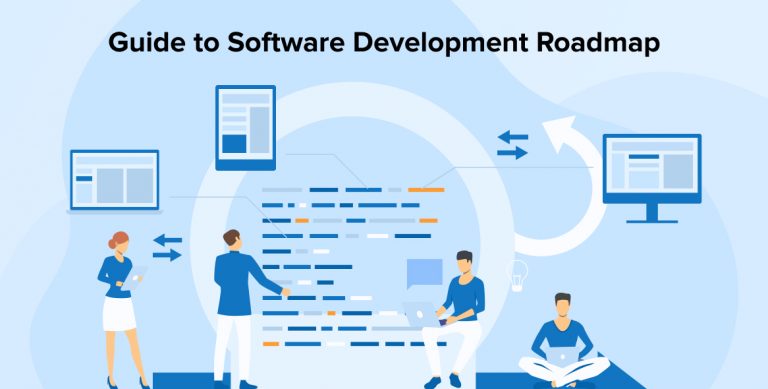
Software development roadmap is critical for confirming the product development process to ensure that all the routine activities align with and contribute to your higher-level business procedure. Software roadmaps are effective because they can be used in many ways such as creating transparency, tracking progress toward your objectives, building consensus and understanding within the development teams, prioritizing initiatives and activities, and much more.
When you’re in a different country where you are unaware of the routes, the first option that will come to your mind will be using Google Maps as it will help you get the directions where you’re headed. The same goes for businesses while creating a product. Before you start building a software roadmap, you must define your objectives and communicate how short-term efforts will respond to long-term business objectives. This is the aim that needs to be achieved by a software development roadmap.
In this post, you’ll learn everything about software development roadmap and how to create a practical roadmap, its benefits, and amazing tools that will help you create it in the least time possible. Without any further ado, let’s get started!
1. What is a Software Development Roadmap?
A software roadmap offers a high-level plan of the software development progress and its objectives. Basically, it is a tool used to share the products’ strategy and communicate effectively. This high-level plan retains both mid-term and long-term solutions and all the required features.
You can track your project’s progress easily and keep an eye on your predefined business strategy, objectives and milestones. A software roadmap is a visual summary that outlines the project’s vision and direction as well as makes the entire software development process smooth to both client and custom software development company.
Apart from this, it helps software managers to align the companies’ goals and help them to achieve those business goals in the least time possible. More than 60% of development teams use software development lifecycle strategies such as Waterfall and the Agile model to outline future product functionality and deliver the same in a minimum period of time.
2. When and Why do You Need a Software Development Roadmap?
You need a software roadmap to develop an effective software product but for that, you must follow a logical series of phases that will help you have the desired product. Businesses must first determine the product’s vision and translate this vision into a blueprint having all product’s themes and strategic goals. You need a software roadmap to connect the company’s product vision to the tasks that cannot be overlooked for the best quality product.
It is a tool for interacting with your product vision and putting your product plans into action. It also offers all the required deliverables and the sequence of the software project phases that gives a glimpse of its future.
Having a clear overview of your software is important so that your product team members can easily track the progress and manage expectations while the project is going on. Once you’re aware of the development of a software product roadmap, it can help you predict how successful your software will be. You can also optimize the usage of resources and time consumed in it to gain the expected outcome. It also keeps the stakeholders aligned with the company’s priorities and objectives. This twitter user perfectly explains why you need a roadmap.
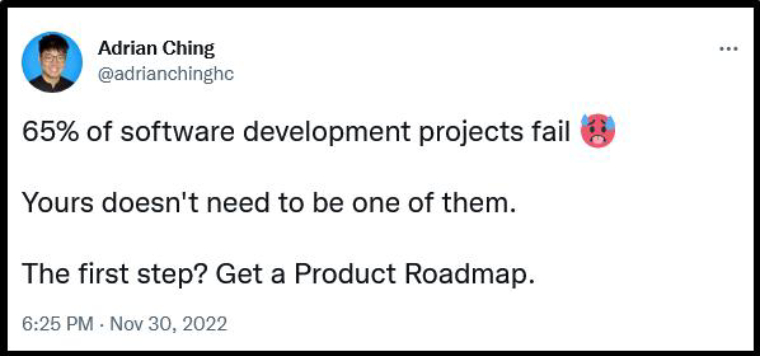
3. Types of Software Development Roadmap
You can create various software product roadmaps depending on your audience type and the number of products involved in them. It allows you to customize the software project plan depending on the type of software roadmap. Mainly two types of roadmaps are most commonly used by businesses and they are internal and external software product roadmaps. Both these roadmaps are examples of group-oriented roadmaps. Multiple teams engaged in the project might need different roadmaps depending on their requirements.

3.1 Internal Roadmap:
- An internal roadmap represents the company’s in-house teams. The roadmap focuses on business strategies, planning, and testing depending on the group you choose to work with and helps you to achieve your predetermined objectives and goals. Basically, this type of roadmap is used for internal teams such as the company’s executives and management executives.
3.2 External Roadmap:
- An external roadmap is especially for key stakeholders as it focuses on some particular details depending on the audience like features, customer benefits, testing efforts, and much more. However, it will be fair to say that the external roadmap is all about achieving milestones and the deliverables that are taken out at the initial stage of the development.
Not all roadmaps need to be group-oriented. Here are a few examples of other types.
3.3 Outcome-Oriented Roadmap:
- An outcome-oriented roadmap aims to focus on the results of the work. All the stakeholders from client to developers will work to get an outcome rather than outputs. An outcome vision will be defined and a process will be made to achieve that outcome. A status-oriented roadmap allows your development team and its team members to track progress, see the current status of the project, and check whether they are on the same page or not. Through this, you can easily check the status of planned features and functionalities that need to be added to the project and it enables easier following of progress. In short, you can say that a status-oriented roadmap facilitates prioritization.
3.4 Theme-Oriented Roadmap:
- A theme-oriented roadmap aims to deliver planned values that are divided into quarters based. These divided values can be on a yearly long-term goal or it might be short-term as well.
These are the most widely used and popular types of software development roadmaps amongst companies who’re planning software project development. There is more variety available of roadmaps that helps you to identify the one which meets your project requirements at its fullest. Hence, it will be fair to say that software roadmaps are highly adaptable tools for companies as it allows them to focus on doing the right things and achieve success at an initial stage.
4. Benefits of a Software Roadmap
Let’s have a look at the benefits software development roadmap provides.
4.1 Define the Purpose of the Software and Your Customers
One of the most common mistakes software developers & product owners make while building a software product roadmap is not having a well-defined purpose. It is important that you have a clear idea of what you are building, what product features you want to add, and who your target audience is. If all these things are defined at an initial stage before you start building your product, you’re likely to gain success in the least time possible. But if you overlook this, you might experience many road bumps that can put your entire product at stake.
Once you have the purpose of the project, you can easily trace a vision that helps your team members to work on a common goal and achieve the same. Hence, it is essential to maintain consistency in what will be delivered so make sure to have shared goals and a common vision.
Ask the below-mentioned questions to yourself as it will help you to know the purpose of your product:
- Why do you want to develop this product?
- What are the advantages of building this product at this time?
- If I tend to build this product, will it help my users?
If you know the purpose of your product then you can surely know your customers. Make sure that software product roadmaps work across various areas and not just one.
4.2 Identify Your Objectives and Key Results (OKRs)
As numerous companies have already started adopting objectives and key results which help them define the predetermined objectives and set their goals. When it comes to software project managers, OKRs allow them to trace a plan and align it with its general mission.
Now you must be wondering why OKRs are so important in product management. It is important because it helps development teams define the steps that must be performed depending on the particular time frame.
Let’s take an example and understand this in detail:
– Objective: Enhance the User Experience of a Website
– Key outcome #1: Decrease new user signup time to 30%.
– Outcome #2: Boost task success rate from 70% to 80%.
– Outcome #3: Improve System Usability scale from 80 to 90.
4.3 Define Software Features, User Stories, and Timelines
Create user stories and define features that have in-depth details so that it helps the development team to know what exactly they need to perform in each user story. Also, coordinate with the internal teams and set realistic timelines. Make sure to stay focused on the company vision while building a software roadmap to eliminate too many details.
4.4 Review Your Roadmap Regularly and Be Ready to Update It
Once your product development roadmap is ready, make sure to share it with your key stakeholders and ask them to give feedback and make changes accordingly to that. The product roadmap is not based on a fixed plan as it continuously evolves and due to this reason, the priorities might change while executing the plan.
So make sure to keep track of the changes you perform and update the software roadmaps on a daily basis. Also, there might be an addition of new features depending on the requirements of the product roadmap, so make sure to add those new pieces of information and do inform your key stakeholders about the changes you made.
5. Best Tools to Create a Software Development Roadmap
Below are some efficient tools that can be helpful in creating software development roadmap.
5.1 Aha!
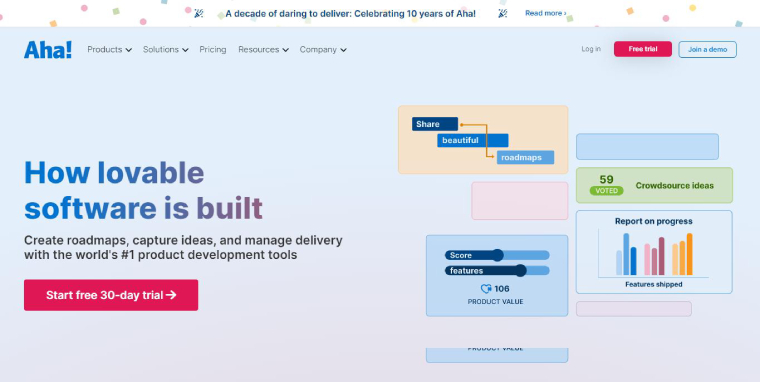
Aha! is a leading product management tool that product managers highly use to create a compelling visual roadmap. It currently has more than 500,000 users which includes tech giants such as Dell and LinkedIn. Because it allows you to create a timeline with all the details that are custom to specific stakeholders. By using the drag-and-drop builder available in this tool, you can easily collaborate with your team members and pass important information on the timeline.
Using this effective tool, users can create attractive visual software product roadmaps using their templates.
The cost plan for Aha tool started from $59 per user for a month if paid annually. You can have a 30-day free trial where you can test all the features and functionalities in the Enterprise plan. If you’re willing to buy the paid package then you can, depending on your product requirements.
Features of Aha!
- You can easily integrate with various platforms such as JIRA, Google Drive, GitHub, and much more.
- You can articulate your business model and vision at its best.
- Aha! tool allows stakeholders and customers to share their ideas freely in the same space.
- You can prioritize the features.
- Team members can easily customize the tool depending on their requirements.
5.2 ProductPlan
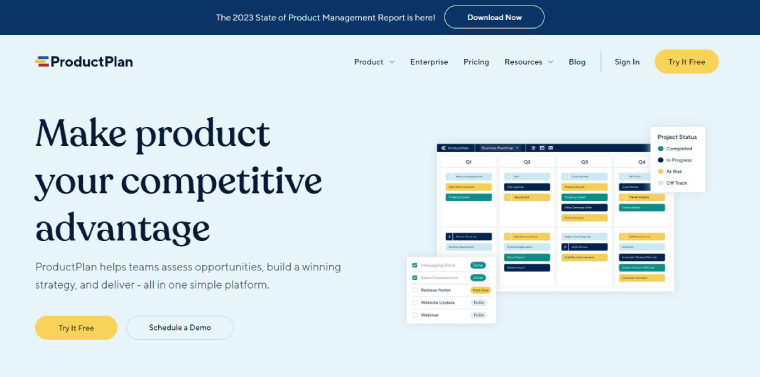
ProductPlan is another great tool for software development roadmap that allows you to easily build and share roadmaps cost-effectively. Product managers who’re looking to impress stakeholders through a visual roadmap will enjoy using Product Plan. Here you can easily customize templates of your choice using the drag-and-drop builder.
You can visually create a product roadmap using this development tool as it prefers a visual layout of your projects. One of the main reasons to choose ProductPlan is that agile teams can create multiple versions of the same roadmap for different audiences. ProductPlan is the best option for teams who’re planning to have an extensive collection of off-the-shelf roadmap templates.
Features of ProductPlan
- Fully customizable layouts
- Calendar and contact management
- Easy integration with other project management tools
- Offers drag-and-drop feature
- Collaboration functionality
5.3 Roadmap Planner
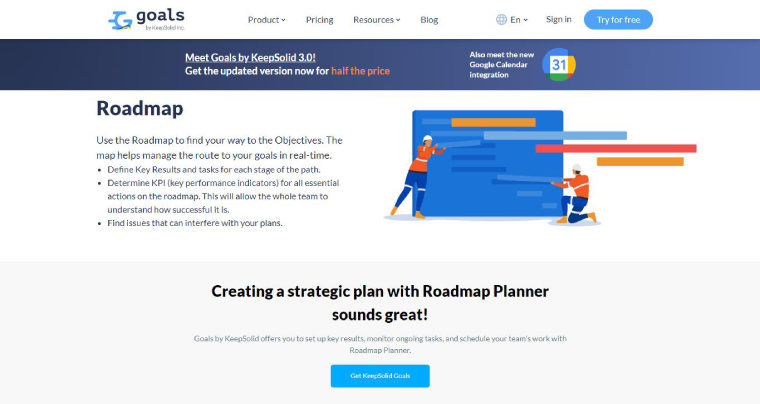
Roadmap planner consists of product roadmap software that focuses on collaboration and planning. You can easily create ideas and strategies as it offers an amazing drag-and-drop interface. Users have complete control over the product roadmap tools. Those development teams who want to keep track of the stages involved in the software product development must use Roadmap Planner as it works best for them.
You don’t need an active Internet connection to use this platform. Also, make sure to use a Roadmap planner for teams who’re working on the planning phase of product development. It provides excellent team control which makes progress tracking easier.
Features of Roadmap Planner
- Advanced synchronization features
- URL-based roadmap sharing
- Online and offline workability
- Backlog management
- Supports multiple languages
5.4 Airfocus
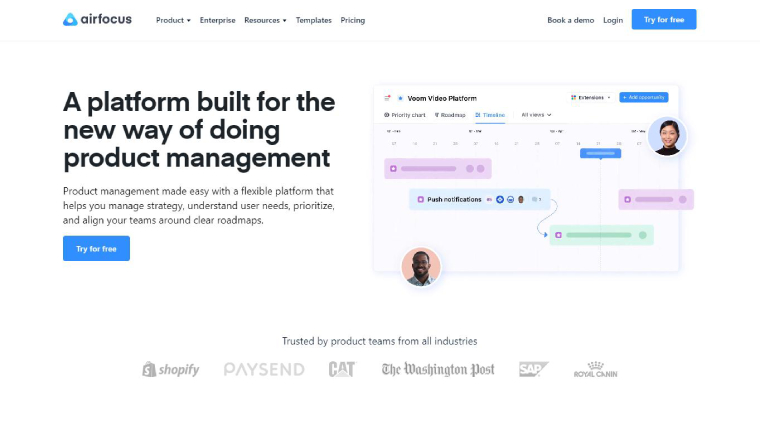
This development platform is specially designed for product road mapping so that you can easily match your team’s collaboration style. It provides an easy-to-use roadmap builder which is customizable and helps you to meet the software product team’s requirements.
You’ll get various views including tables, kanban boards, timelines, and much more. If you’re willing to use this platform, you’ll surely get a bunch of notable features to automate prioritization.
Features of Airfocus
- Easy to use
- Frameworks and formulas are customizable
- 24×7 customer support
- Easy collaboration in real-time
- Flexibility of sharing with unlimited viewers
6. Final Thoughts
In closing, we would like to say that a software product roadmap is one of the best ways to show how a digital product develops and achieves its intended business objectives in the least time possible. Building a software development roadmap involves various important steps. It includes identifying the business vision, knowing business strategies, and updating the roadmap daily to reflect its current state.
Giant development companies also build software development roadmaps and scale the business strategies to keep up with the current trends. But if you find any challenges while building a plan, make sure to hire a top-notch software development company to overcome such challenges and align with your objectives.


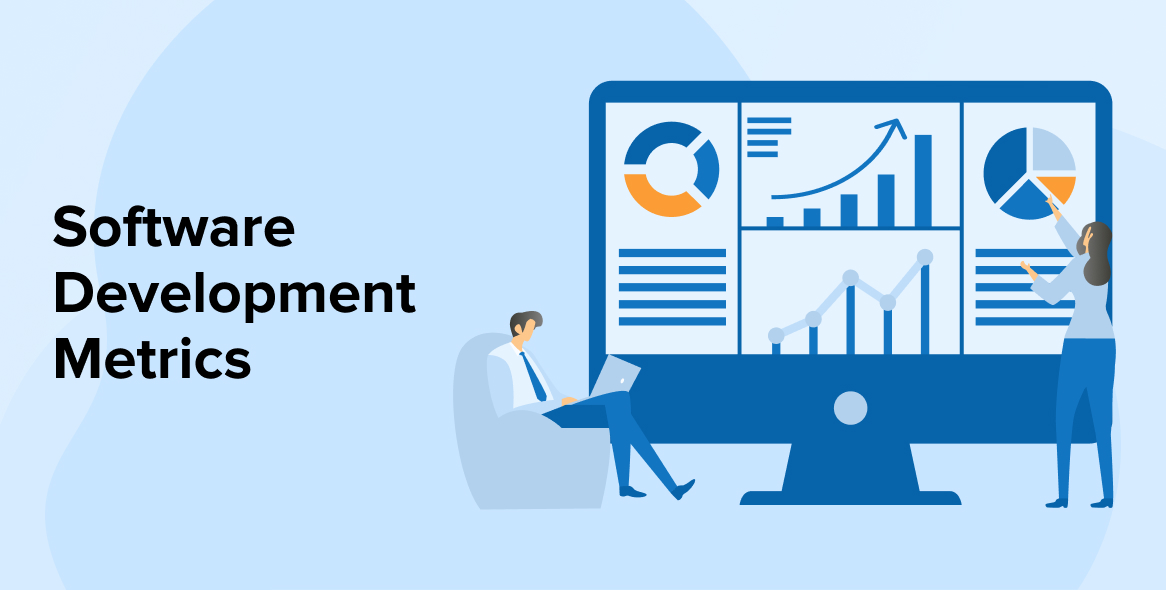
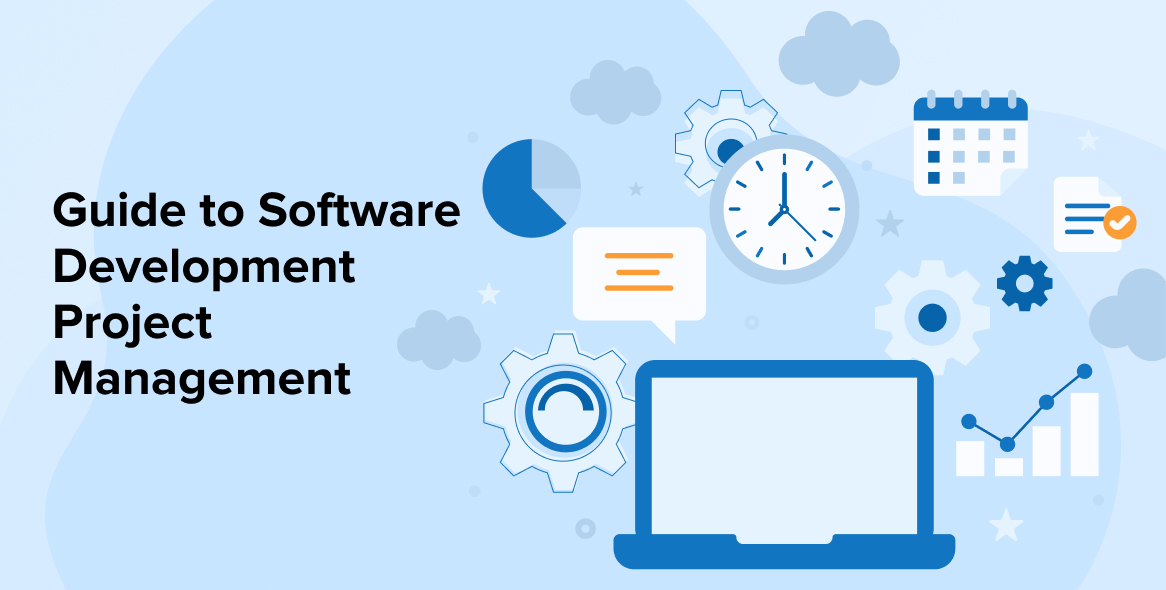
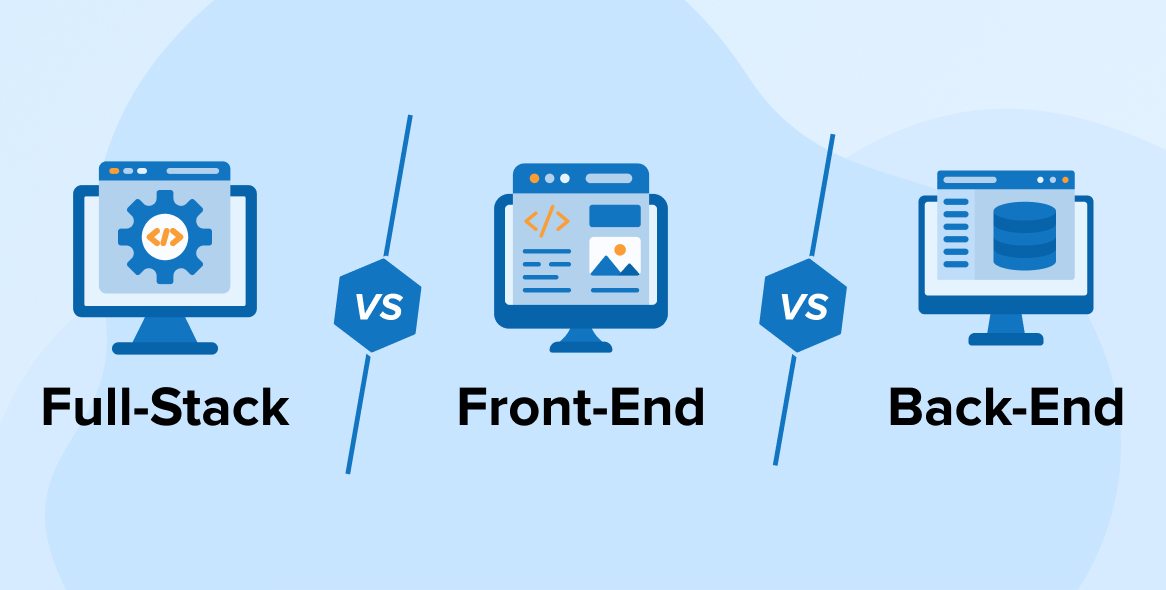

The author does a good job of explaining the different components of a software development roadmap. Article provides some practical tips on how to create a roadmap, such as starting with the end in mind and involving stakeholders early on.
I enjoyed how the article differentiated between the various stages of the software development process. This made it simple to understand the many duties that needed to be fulfilled at each stage.
This is an excellent and comprehensive overview of the importance of software development roadmaps and how to create them effectively. Furthermore, the list of recommended tools for creating software development roadmaps is a valuable resource